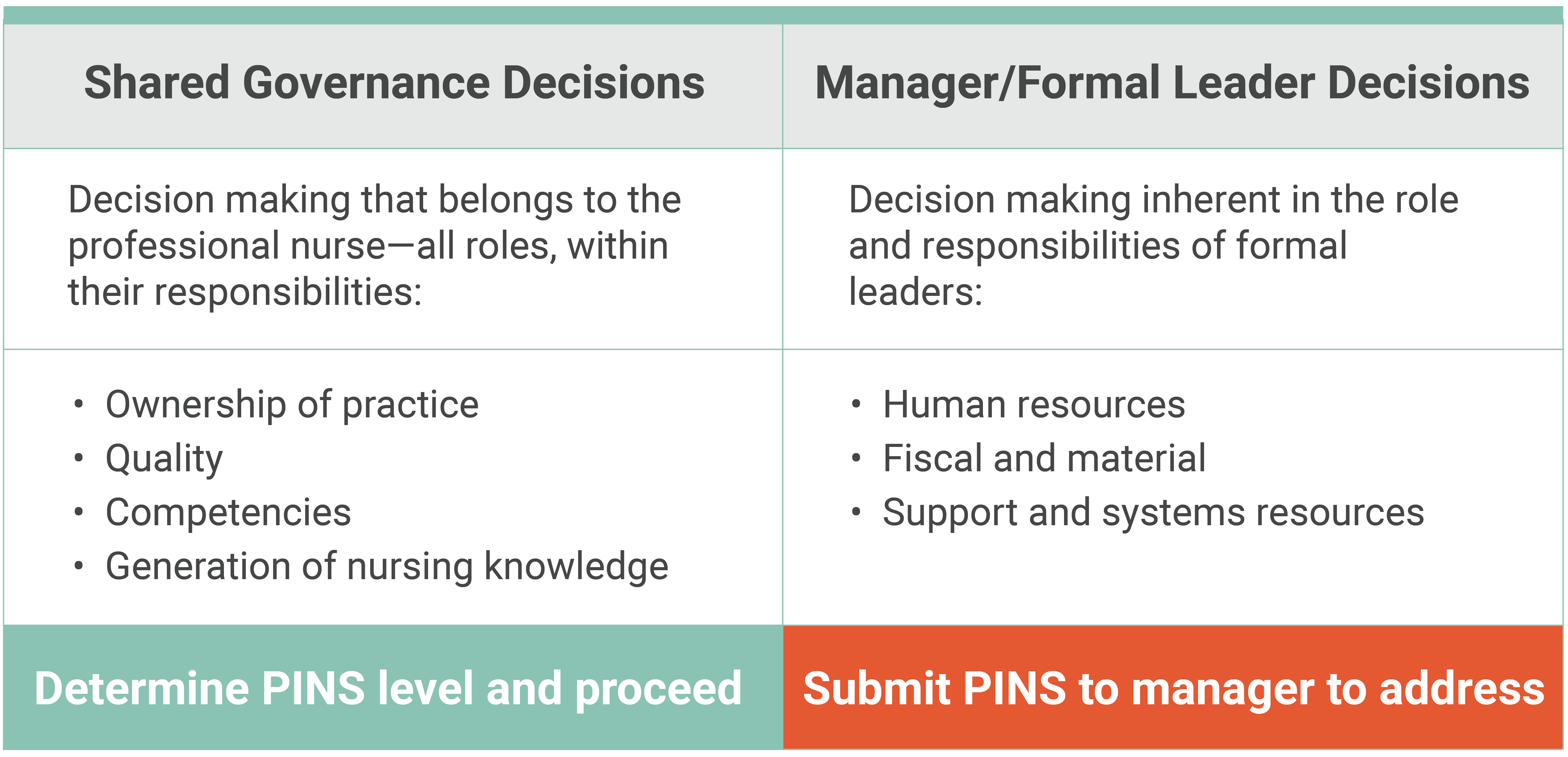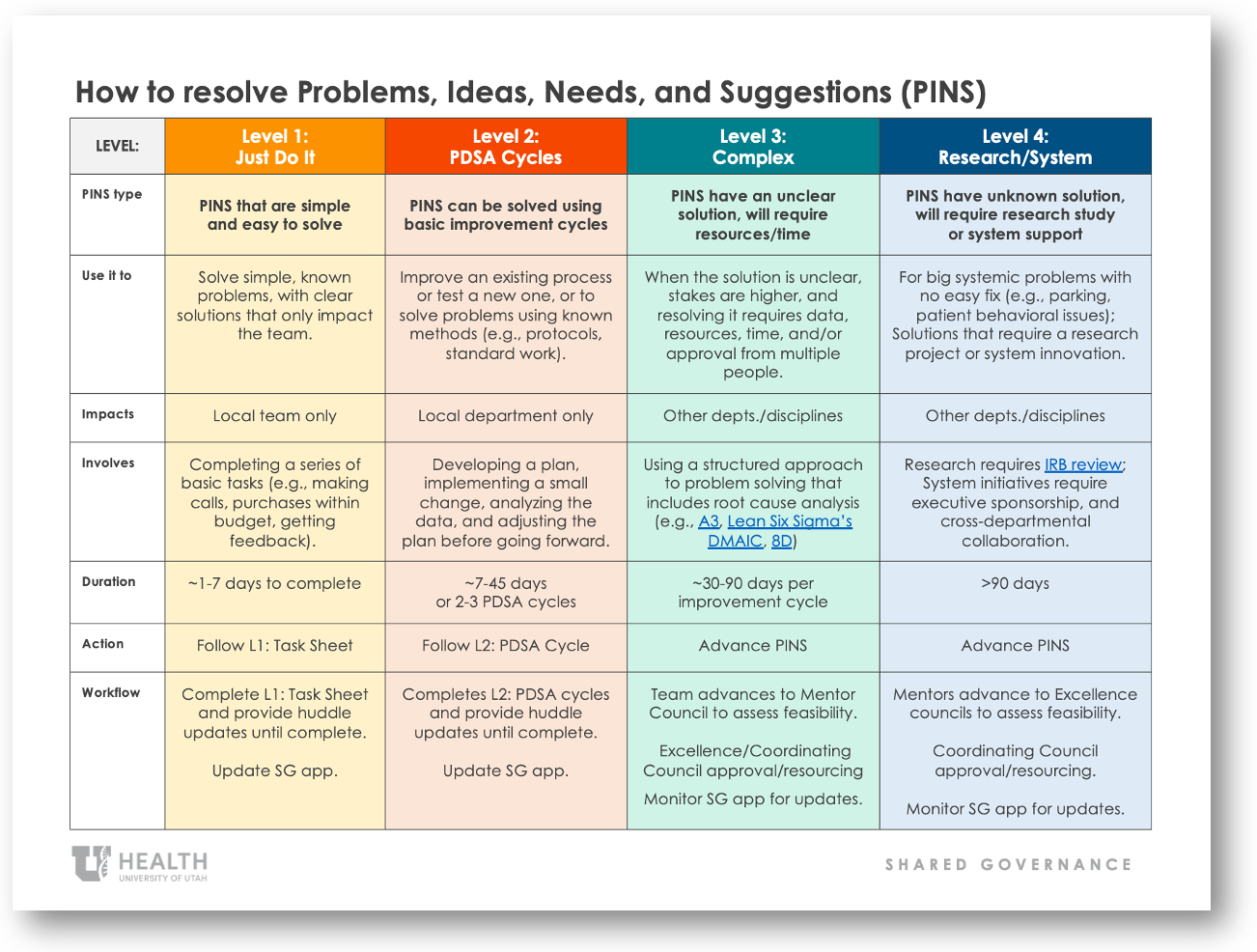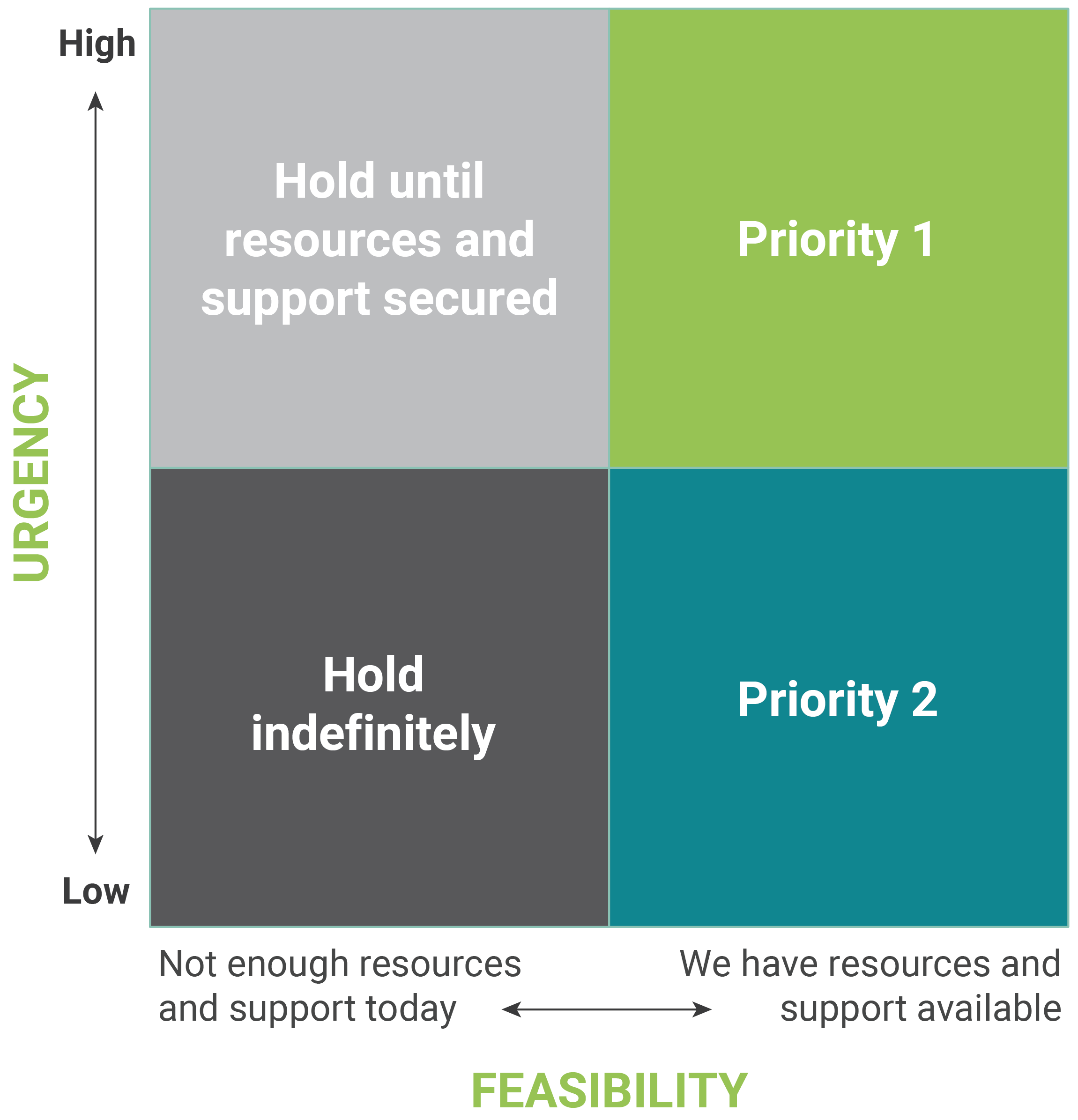Introduction to SG Decision Making

The Shared Governance Advancement Team explains what shared governance is and is not, here.
teams begin to huddle and discuss shared governance problems, ideas, needs, and suggestions (PINS), they quickly find that some PINS are simple to resolve as a team, while others feel overwhelmingly beyond their control.
The 3 D’s of Decision Making Framework is a guide for working on PINS as a team:
- Discuss
- Decide
- Do the work—together
Use the table below to determine if this is a decision the team can make on their own:

 Next, use this "How to Resolve PINS Guide" to determine the level of difficulty to resolve (L1-L4). It can help you understand how long it will take, who might be needed, and if/when to advance to other councils for assistance.
Next, use this "How to Resolve PINS Guide" to determine the level of difficulty to resolve (L1-L4). It can help you understand how long it will take, who might be needed, and if/when to advance to other councils for assistance.
 Determine PINS priority and whether to pursue.
Determine PINS priority and whether to pursue.
What is the degree of URGENCY?
- High = preventing work
- Medium = needs attention
- Low = nice to have
What is the FEASIBILITY?
- Can the PINS be achieved with existing resources?
- Does the team have bandwidth to address?
Is it IMPORTANT to the team?
- All members should feel accountable for the group’s decisions and final outcomes.
- If you don’t have consensus, take a vote! (see Shared Governance Bylaws ↓ )
Designate who will do what, by when.
All members should feel accountable for the group’s decisions and final outcomes.
1. Identify team members to work on PINS.
- Ask for volunteers. Start with the individual(s) who identified the PINS.
- If no one volunteers, consider if this is something that meets urgency/feasibility criteria and if it should be placed on hold.
- Consider initially partnering less experienced staff with more experienced staff to foster skill development and increase confidence in abilities.
2. Once staff are identified to work on PINS:
- Refer to the “How to Complete PINS Toolkit” for templates to guide your work.
- Team Chairs enter PINS into Empower U Website and informs manager of support needed (if any).
- Work with manager:
- Resources and support
- Remove barriers
- Create time for team to work
- During shift (redistribute workload)
- Designate protected time away from regular work duties/hours
What happens when we don't all agree?
Disagreement is a normal, healthy part of shared decision making. To help make it easier for teams, the Shared Governance Bylaws has a special section on voting. Team Chairs help lead the voting process. We've adapted the bylaws below to help you get started.
How to Avoid Groupthink

Consensus occurs when everyone is present and in agreement. We achieve consensus, or group agreement, by discussing ideas and opinions in a respectful manner during huddles or meetings. It's crucial to recognize that disagreement isn't a bad thing; rather, it helps us steer clear of groupthink. Groupthink arises when teams prioritize consensus over critical thinking in decision-making, potentially leading to flawed decisions, limited perspectives, and unwarranted confidence.
2. If no consensus, take a vote!
If everyone isn’t on board, the Team Chair leads a vote using the following four principles:
 Representation: “Representation” means that Team Chairs make sure that team members affected by the decision are included in the decision-making. If team members aren’t present for the vote, they can share their vote with another team member or Team Chair before/after the discussion.
Representation: “Representation” means that Team Chairs make sure that team members affected by the decision are included in the decision-making. If team members aren’t present for the vote, they can share their vote with another team member or Team Chair before/after the discussion.
- Voting options (find one that works best for your team):
- Leave tick marks on PINS
- Post a voting sheet on unit/in clinic
- Electronic polls with a deadline
 Quorum: A “quorum” is the minimum number of team members that need to be present to make a decision. Team Chairs can determine a quorum for PINS that have limited impact on the team (e.g., L1 PINS). The vote can then be taken by all members present at the time. For Excellence Councils, a quorum must have at least 50% members present of which at least 75% are clinical RNs and no more than 25% can be leaders.
Quorum: A “quorum” is the minimum number of team members that need to be present to make a decision. Team Chairs can determine a quorum for PINS that have limited impact on the team (e.g., L1 PINS). The vote can then be taken by all members present at the time. For Excellence Councils, a quorum must have at least 50% members present of which at least 75% are clinical RNs and no more than 25% can be leaders.
 Voting: Team Chairs can also request that absent team members vote on the issue before a final decision is made:
Voting: Team Chairs can also request that absent team members vote on the issue before a final decision is made:
- Adoption of a decision, with a quorum, is two thirds of the vote (clear majority).
- Abstentions (declining to vote) are excluded when calculating a vote.
 Tiebreaker: The team will adopt the chair/co-chair’s vote(s) as the final direction to resolve any tie-breaker situations.
Tiebreaker: The team will adopt the chair/co-chair’s vote(s) as the final direction to resolve any tie-breaker situations.
3. Appeals process
If a team member(s) strongly disagrees with the final decision or how the decision was made, they can escalate concerns in writing to AskNursing@hsc.utah.edu no later than 2 days after the motion has passed. A member of the Coordinating Council will review all concerns and help determine next steps.
See the complete Shared Governance Bylaws here.
Annie Kamerath
Consuelo Ogden
Jannda Bartlome
Kim Mahoney
Mary-Jean (Gigi) Austria
Sara Clark
Tina Hepner
Zlata Muhamedagic
Health systems across the nation utilize shared governance programs to empower teams to make decisions impacting their practice and area of work, increase accountability and autonomy, and improve quality of patient care. The U of U Health Department of Nursing offers its model, along with tips, to assist any team in implementing shared decision-making in their respective areas.
The Shared Governance Support Team has developed a list of resources for new shared governance leaders to equip them to lead and guide team members in engaging in shared decision-making at the local level.
As teams across the UUHC Department of Nursing work to implement shared governance in their areas, we’re learning about team experiences and the impact shared governance has had so far. This month, Lauren Studiner from HCH 4B shares how shared governance helped her team overcome workflow challenges and create a more inclusive culture around idea-sharing and decision-making.
